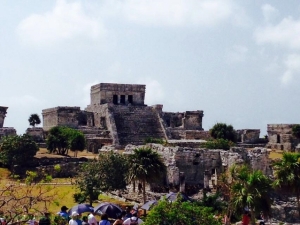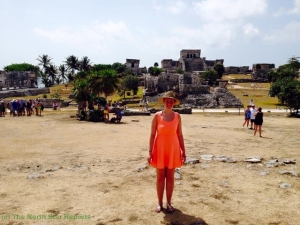Learning Through Song – by Tayler Boelk. The North Star Reports: Global Citizenship and Digital Literacy, at NorthStarReports.org and facebook.com/NorthStarReports
[Source of image, see: https://commons.wikimedia.org/wiki/File:Edmund_Fitzgerald,_1971,_3_of_4_(restored).jpg]
Everything I learned about the Edmund Fitzgerald, a famous Great Lakes shipwreck, I learned through song. I can tell you how many tons of iron ore was on the ship—about 26,000. I can tell you where they were coming from—Wisconsin,- and where they were going—Cleveland. I can even tell you how many people died when it sank to the bottom of Lake Superior—29.
Song has been, and continues to be, a great method of learning. An excellent example of this is the children’s song “The ABC’s.” In the United States, this is how children learn the basic units of communication. Through song, they learn the letters used to build words for both speaking and writing. Language is an interactive and social process, and music is a natural way for children to experience this process in a pleasurable way. As schooling continues, learning through song remains present. School House Rock and Animaniacs were popular educational television shows that taught the continents, presidents, states and their capitals, parts of speech, and even more universal things such as countries of the world. Some songs are used to encourage cooperation and problem solving. The “Clean-Up Song,” for instance, was a popular one from kindergarten, teaching children that the best way to get work done quickly is to work together. While these are dominantly western examples, the great thing about music is that it spans across the globe.
Music exists in every culture. It varies in style, language, and message, but it is one of the most powerful ways of understanding the differences and similarities of others. It is universal in that music always speaks to the human experience. Even when we listen to music in languages we cannot understand, we receive a lasting impression of the challenges, sorrows, and joys of that culture. It is this emotional experience that really connects a listener with the music. This connection breaks language barriers allowing us to learn about other cultures and from others’ experiences. In addition, the rhythm and patterns of song can help us learn language easier. In a choral setting, I have much experience singing in foreign languages. Most of the learning was done through the active singing of the song. Sure, we learn things via lecture or reading but by simultaneously reading lyrics, hearing them, and actively singing them, we are processing the information in several ways rather than one at a time.
This applies to music in familiar languages by allowing us to quickly memorize the information through use of familiar patterns. You don’t have to be a music prodigy to recognize rhyming schemes or the difference between the chorus and verse. In our everyday experiences of listening to music on the radio, in movies, commercial jingles, or music classes we become familiar with these patterns. Singers and song writers take advantage of these patterns to tell stories or teach lessons. As I mentioned before, everything I know about the Edmund Fitzgerald I learned through song. Gordon Lightfoot’s song, “The Wreck of the Edmund Fitzgerald” is arguably the source of the ships fame. His song follows many traditional methods of storytelling including foreshadowing, similes, and contains a beginning, middle, and end. While this story could easily be told verbally, by putting it to song and adding additional literary techniques, such as rhyming and alliteration, it becomes instantly more memorable.
Johann Wolfgang von Goethe, a famous German writer, once stated that music is “the language of the heart.” While this is beautiful, I would argue that music is the language of the world. It brings people together from across the globe and helps them understand and enjoy each other’s culture.
Tayler Boelk serves as assistant editor for The North Star Reports.
—
Please contact Professor Liang if you wish to write for The North Star Reports — HLIANG (at) css.edu
See also, our Facebook page with curated news articles at http://www.facebook.com/NorthStarReports
–
The North Star Reports: Global Citizenship and Digital Literacy (http://NorthStarReports.org) is a student edited and student authored open access publication centered around the themes of global and historical connections. Our abiding philosophy is that those of us who are fortunate enough to receive an education and to travel our planet are ethically bound to share our knowledge with those who cannot afford to do so. Therefore, creating virtual and actual communities of learning between college and K-12 classes are integral to our mission. In five semesters we have published 200 articles covering all habitable continents and a variety of topics ranging from history and politics, food and popular culture, to global inequities to complex identities. These articles are read by K-12 and college students. Our student editors and writers come from all parts of the campus, from Nursing to Biology, Physical Therapy to Business, and remarkably, many of our student editors and writers have long graduated from college. We also have writers and editors from other colleges and universities. In addition to our main site, we also curate a Facebook page dedicated to annotated news articles selected by our student editors (http://www.facebook.com/NorthStarReports). This is done by an all volunteer staff. We have a frugal cash budget, and we donate much of our time and talent to this project. We are sponsored by St. Scholastica’s Department of History and Politics and by the scholarly Middle Ground Journal: World History and Global Studies (http://theMiddleGroundJournal.org).
For a brief summary, please see the American Historical Association’s Perspectives on History, at: http://www.historians.org/perspectives/issues/2013/1305/Opening-The-Middle-Ground-Journal.cfm
Hong-Ming Liang, Ph.D., Editor-in-Chief and Publisher, The North Star Reports; Chief Editor, The Middle Ground Journal; Associate Professor of History and Politics, The College of St. Scholastica.
Kathryn Marquis Hirsch, Managing Editor, The North Star Reports.
(c) 2012-present The North Star Reports: Global Citizenship and Digital Literacy http://NorthStarReports.org ISSN: 2377-908X The NSR is sponsored and published by Professor Hong-Ming Liang, NSR Student Editors and Writers, The Department of History and Politics of The College of St. Scholastica, and the scholarly Middle Ground Journal. See Masthead for our not-for-profit educational open- access policy. K-12 teachers, if you are using these reports for your classes, please contact editor-in-chief Professor Liang at HLIANG (at) css.edu
























